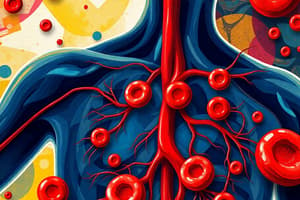Podcast
Questions and Answers
Where does gas exchange take place in animals?
Where does gas exchange take place in animals?
- Alveoli (correct)
- Chloroplast
- Mesophyll cells
- Stomata
What is the role of the heart in animals' gas exchange?
What is the role of the heart in animals' gas exchange?
- Regulating gas exchange
- Absorbing oxygen
- Ensuring circulation of blood and oxygen (correct)
- Producing carbon dioxide
Which of the following is NOT part of the human respiratory system?
Which of the following is NOT part of the human respiratory system?
- Pharynx
- Trachea
- Nose
- Chloroplast (correct)
What microscopic structures regulate gas exchange in plants?
What microscopic structures regulate gas exchange in plants?
What surrounds the alveoli to ensure efficient exchange of gases between air and bloodstream?
What surrounds the alveoli to ensure efficient exchange of gases between air and bloodstream?
What cellular organelle enables photosynthesis in plant cells?
What cellular organelle enables photosynthesis in plant cells?
What process do animal cells primarily use mitochondria for?
What process do animal cells primarily use mitochondria for?
What is the function of the cell membrane in maintaining homeostasis?
What is the function of the cell membrane in maintaining homeostasis?
Which factor was NOT mentioned in the text as contributing to poor health outcomes?
Which factor was NOT mentioned in the text as contributing to poor health outcomes?
What is emphasized as a cornerstone of understanding the living world in the text?
What is emphasized as a cornerstone of understanding the living world in the text?
Flashcards are hidden until you start studying
Study Notes
The Majestic Dance of Breath and Exchange: A Biological Perspective
From the elegant inner workings of the cell to the intricate dance of breath and exchange in all living organisms, we embark on a journey to explore the marvels of life's fundamental processes. We'll focus on how plants and animals exchange gases, the role of cells in these processes, and the profound impact of socioeconomic factors on health.
Plants: The Art of Gas Exchange
With their roots firmly planted in the earth and their leaves reaching for the sky, plants have perfected the art of gas exchange. Their ability to absorb carbon dioxide (CO₂) and produce oxygen (O₂) through photosynthesis is essential to sustaining life on Earth.
At the heart of this process lies the stomata, microscopic pores that open and close to regulate gas exchange. The plant's mesophyll cells, with their internal structures like the chloroplast and the cell plate, drive photosynthesis.
Animals: The Dance of Breathing and Circulation
Unlike plants, animals rely on specialized organs to exchange gases. In humans, the lungs are the site of gas exchange, while the heart ensures the continuous circulation of blood and oxygen to every cell in the body.
The respiratory system consists of the nose, the pharynx, the trachea, the bronchi, and the bronchioles, which finally lead to the alveoli, the gas exchange units of the lungs. The alveoli are surrounded by a dense network of capillaries, ensuring efficient exchange of gases between the air and the bloodstream.
Cells: The Basic Building Blocks
In both plants and animals, cells serve as the fundamental units of life. Plant cells contain chloroplasts, which enable photosynthesis, while animal cells contain mitochondria, which generate energy through cellular respiration.
The cell membrane serves as a barrier, allowing some substances in and out while blocking others. This selective permeability is vital for maintaining homeostasis and the proper functioning of cells. In both plants and animals, the cytoskeleton contributes to cell structure and movement, supporting the cell's vital functions.
Socioeconomic Factors and Health
Inequality can have significant, detrimental effects on health. In a study by the National Academies of Sciences, Engineering, and Medicine, socioeconomic factors were found to contribute to poor health outcomes, including chronic inflammation, chromosomal aging, and brain dysfunction. Factors like stress, poor nutrition, and lack of access to healthcare can negatively impact health, underscoring the importance of addressing socioeconomic factors to improve overall well-being.
Conclusion
The dance of breath and exchange is a fundamental process that sustains life. From the intricate mechanisms of gas exchange in plants to the coordinated actions of the respiratory system in animals, these processes are driven by the complex workings of cells. Understanding the interplay between socioeconomic factors and health offers insights into how we can improve the well-being of individuals and communities.
As we continue to explore the wonders of life, the exchange of gases will remain a cornerstone of our understanding of the living world. By delving into the intricacies of these processes, we not only enhance our knowledge but also enrich our appreciation of the marvels of life.
Studying That Suits You
Use AI to generate personalized quizzes and flashcards to suit your learning preferences.





